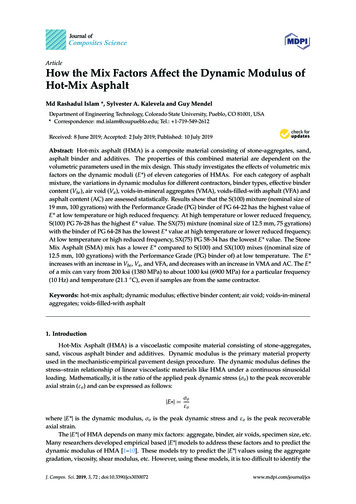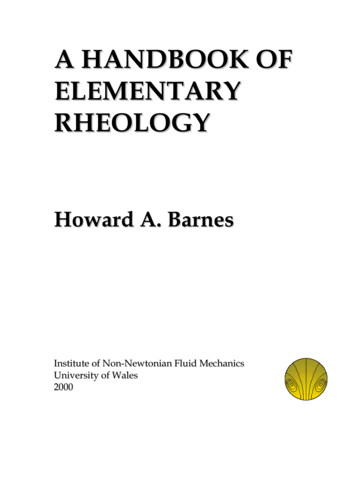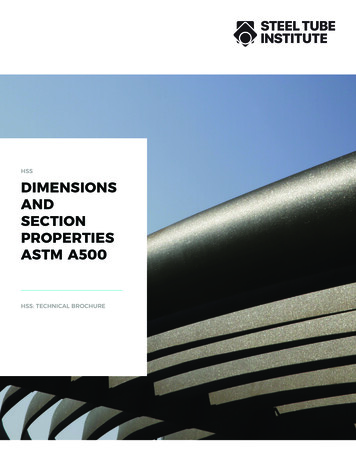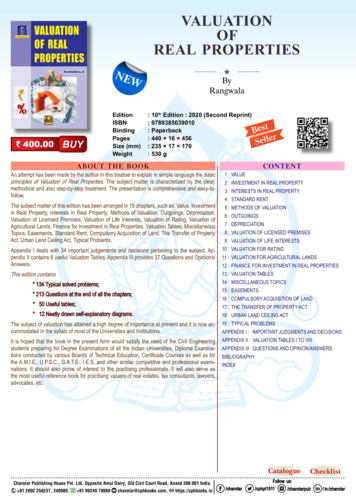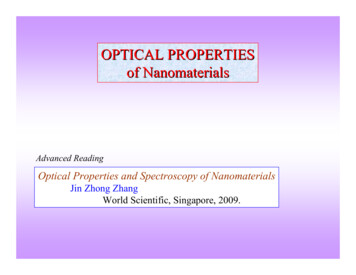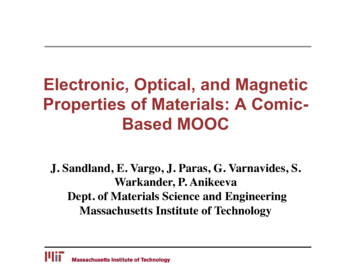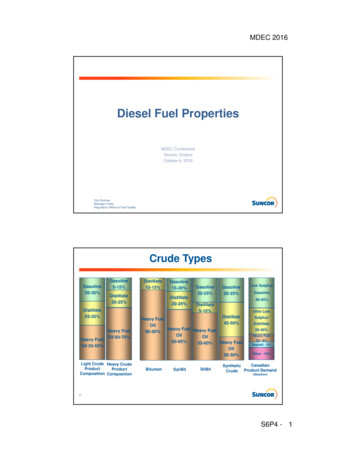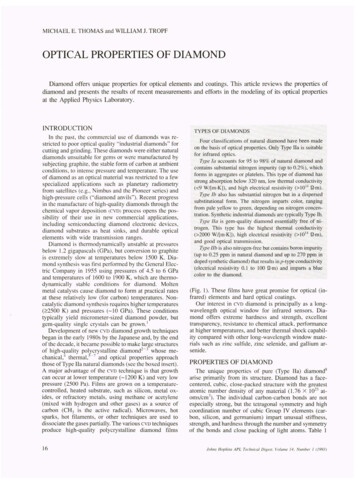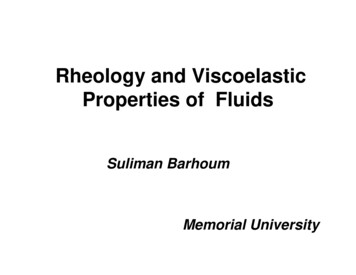
Transcription
Rheology and ViscoelasticProperties of FluidsSuliman BarhoumMemorial University
Outlines Liquid behaviour. Newtonian liquid. Non-Newtonian liquid. Colloidal systems and suspensions. Definition and classification. Rheometers. Concentric Cylinder Rheometer. Capillary Rheometer. Applications. Conclusion.
Liquid BehaviourNewtonian liquidsThe shear thinningliquidsThe shear thickeningliquids
Colloidal systems and suspensions Colloidal systems. Classification. Why colloidal systems?
Colloidal Systems It is a uniform distribution of large solute size particles (1nm to 1000 nm)inside a solvent phase. The main forces:1.2.3.4.Electrostatic force (Repulsive):It is a simple Coulomb interaction between the same chargedsuspended particles.Polymer stabilization force (Repulsive):Created due to existence of adsorbing polymer on the surface ofcolloidal particles.Depletion force (Attractive):Created due the to existence of non-adsorbing polymers in thesolution.Hydrodynamic force:Suspended colloidal particles are influenced by the flow of thesolution which results due to a movement of a colloidal particle.
ClassificationAerosols Dispersion of liquid droplets in a gas. [Fog].Dispersion of solidparticles in a gas.[Smoke]EmulsionsDispersion of one liquid in another one (two mages?hl en&q paints&btnG Search Images&gbv 2SuspensionsDispersion of solid particlesin a liquid medium. [paint]
Why colloidal systems? They are used to produce many ofindustrial and food products which areused in our daily life such as : cheese, ink,milk, paint etc .
Rheometers Uses:1.2.3.4.Viscosities.Shear stress with respect to shear strain rate behaviour.Pressure gradient of the fluid.Velocity profile.5. Storage and Loss modulus.
Rheometers Concentric Cylinder Rheometer The narrow gap concentric cylinder rheometer. The wide gap concentric cylinder rheometer. Capillary Rheometer
Concentric Cylinder Rheometer Two concentric cylinders of radii R1 and R2. A relative angular velocity (Ω) of one cylinderwith respect to another one. The shear stress (σ) at any cylindrical surfaceof radius (r) is:G : “is the torque per unit length acting on the liquid cylindricalsurface of radius r”. The strain rate:. rd drω : Is the relative angular velocity between i.e.: the inner cylinderand the liquid cylindrical surface of radius (r)http://images.google.ca/images?gbv 2&hl en&q conentric cylinder rheometer for suspensions
Concentric Cylinder Rheometer The narrow gap concentric cylinder rheometer: The length (L) of the cylinders is much larger than the radii ; L R1, R2 The ratio of inner cylinder to outer cylinder radii is greater than 0.97. The shear stress :Ra: represents “some average radius” which can be equal [(R1 R2)/2] The shear strain rate: Ra R2 R1 The viscosity:G ( R2 R1 )22 R a .
Concentric Cylinder Rheometer The wide gap concentric cylinder rheometer: The viscoelastic behaviour; shear strain-shear stress relationship for suspensions of largeparticles. For the power law model fluids: K 2 ( ) n 1shear strain rate.2 n(1 b 2 / n )Rb 1R2Shear stress G12 R 12G1: is the torque per unit length acting on the inner cylinder
Capillary Rheometer It consists of Capillary tube of radius (a) and length (L).Lhttp://www.atascientific.com.au/images/photo rheology capillary.jpg
Capillary Rheometer Newtonian fluid:1.2. The pressure gradient depends on the volume flow rate of fluid.The velocity profile , shear stress, and the value of shear straindepends mainly on the radius of liquid cylindrical layer.Non-Newtonian fluid:.n 1For Power Law Model Liquid: K 2 ( )1.2.The pressure gradient depends mainly on the properties of thefluid.The velocity profile depends on both the radius of liquid cylindricalshell layer and the properties of the liquid.
Applications Capillary Rheometer was used to studyand detect the viscosity behaviour of acolloidal silica suspension at differentpolyethylene oxide (PEO) concentrations.A. A. Zaman, M. Bjelopavlic, and B. M. Moudgil. Effect of Adsorbed Polyethylene Oxide on the Rheology of Colloidal SilicaSuspensions. Journal of Colloid and Interface Science 226, 290-298(2000).
Applications Newtonian behaviour up to 30 % VF.Non-Newtonian shear thinningbehaviour at both 40 % and 50 % VF.By increasing the volume fraction ofsilica particles:1.2.More obvious shear thinning behaviourappears.the value of shear rate at which a transitionoccurs from non-Newtonian to Newtonianregion becomes larger.Viscosity Vs Shear strain rate at different colloidal silicavolume fractions for suspensions of 0.6 µm silica particleradius dispersed in a solution contains 2.5 mg/g (solid)of PEO (Mw 7500 g/mole) and 0.01 M of NaNO3.A. A. Zaman, M. Bjelopavlic, and B. M. Moudgil. Effect of Adsorbed Polyethylene Oxide on the Rheology of Colloidal SilicaSuspensions. Journal of Colloid and Interface Science 226, 290-298(2000).
Applications Explanations: Layered structure:Electrostatic repulsionforce and polymerstabilization force aredominant.Transition Disordered structure:Hydrodynamic interactionthat is created due to theshearing process isdominant.
Applications Non-Newtonian shear thinning behaviourover a shear rate range 0.01 to 500 s-1 .Over a shear rate rang larger than 500 s-1: Newtonian:[PEO] 1 mg/(g solid) to 10 mg/(g solid). Non-Newtonian shear thickening:[PEO] 14 mg/(g solid) to 22 mg/(g solid).The viscosity Vs shear rate strain of 0.6 µm silicacolloidal suspension at different PEO concentrationsand 0.01 M of NaNO3.A. A. Zaman, M. Bjelopavlic, and B. M. Moudgil. Effect of Adsorbed Polyethylene Oxide on the Rheology of Colloidal SilicaSuspensions. Journal of Colloid and Interface Science 226, 290-298(2000).
Applications Explanations:At high PEO concentration, most of the added polymer do notadsorb on the colloidal particles such that the concentration of freePEO molecules inside the solution increases which causes anincrease in the depletion forces between the particle in the solutionwhich causes an increase in the viscosity of solution at higher PEOconcentrations
Applications Coaxial Cylinder Rheometer was used to studydynamic measurements which include storagemodulus G\ and loss modulus G\\ for a silicasuspensions in an aqueous solutions consist ofhydroxypropylmethyl cellulose (HPMC) atdifferent silica and polymer concentrations.Yoshitaka Ryo, Yasuhiro Nakai, and Masami Kawaguchi. Viscoelastic Measurements of Silica Suspensions in AqueousCellulose Derivative Solutions. Langmuir 1992,8, 2413-2416.
A plateau in the curve at lowestpolymer concentration which isattributed to theformation of the gel-like structure(solid-like behaviour).G\ and G\\ curves for 1.25 %, 1.5%,and 1.75 %, are intersect eachother at specific frequency values.Intersection point represents atransition from solid-like to liquidlike behaviour.The value of frequency ;at whichthe intersection occurs; decreasesby increasing the polymerconcentration.Yoshitaka Ryo, Yasuhiro Nakai, and Masami Kawaguchi.Viscoelastic Measurements of Silica Suspensions inAqueous Cellulose Derivative Solutions. Langmuir 1992,8,2413-2416.Log-Log Plots of G\ and G\ Vs frequencyfor 5% silica suspensions at various HPMCconcentrations: a, 1.25%; b, 1.5%; c, 1.75%;d, 2.0%
Applications Explanations: Plateau at lowest HPMC concentration is attributed to the formationof gel structure (solid-like structure) in which the silica particlesattached to each other via polymer chains which adsorb on thesurface of silica particles.www.physics.emory.edu/ weeks/lab/index .html
Applications Explanations:The viscoelastic properties of the solution changes from solid to liquid-likebehaviour by increasing polymer concentration since the concentration ofnon-adsorbing free polymer increases and then the depletion interactionbetween the suspended silica particles increases which createsclusters [Aggregations of silica particles inside the solution]tuberose.com/Hydrogen and Oxygen.html
The value of G\ is alwayslarger than the value of G\\ forall polymer concentrations.which means that the solutionhas mainly solid-like behaviourdue to the formation of gelstructure.Yoshitaka Ryo, Yasuhiro Nakai, and MasamiKawaguchi. Viscoelastic Measurements of SilicaSuspensions in Aqueous Cellulose DerivativeSolutions. Langmuir 1992,8, 2413-2416.Log-Log Plots of G\ and G\ Vs frequencyfor 7.5% silica suspensions at various HPMCconcentrations: a, 1.25%; b, 1.5%; c, 1.75%;d, 2.0%
Conclusion We can use the rheological measurements togive an estimation about:1. The dominant interaction forces between thesuspended colloidal particles in a solution.2. The main internal structure created by thesuspended colloidal particles inside a solution.
Question Is it enough to use rheological measurements to get information about theinternal structure of the solution and to identify the interaction forcesbetween the suspended particles ? Answer :No, it is not enough.We have to support our rheological results by using another techniques;such as NMR or Dynamic light scattering; in order to get more informationabout the main physical parameters; such as diffusion coefficients andrelaxation times; that provide us with more accurate information about theinternal structure and the mutual physical and chemical forces between thesuspended particles inside the solution.
Capillary Rheometer Newtonian fluid:Pressure gradientVelocity of a cylindrical shell of radius (r)dP 8Qη dL πa 4Shear stress1 dPv( r ) ( a 2 r 2 )4 dLdv r dP 4 Qr dr 2 dL a 4. Q: the volume flow rate of the Newtonian liquidShear straindvr dP 4Qr dr 2 dL a 4
Capillary Rheometer Non-Newtonian fluid.Satisfies power Law model K 2 ( ) n 1The pressure gradientdPdL2K a2 (3 n 1)Q na 3 The velocity profilenv(r ) Q(3n 1)r ( n 1) / n(1 ()) a 2 (n 1)a
The viscoelastic behaviour; shear strain-shear stress relationship for suspensions of large particles. For the power law model fluids: shear strain rate Shear stress 2 1 R R b (1 ) 2 2/. n b n 2 1 1 2 R G G 1: is t

